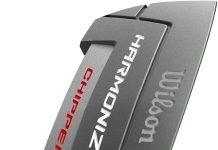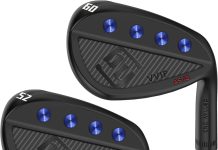Can the Callaway Golf Paradym Star Driver actually help us hit longer, higher shots while keeping things forgiving for moderate swing speed players?
Overview of the Callaway Golf Paradym Star Driver
We see the Callaway Golf Paradym Star Driver as an option built to maximize distance and launch while favoring a draw bias to help players who tend to slice or struggle with fades. The key selling point is the 360 Carbon Chassis that promotes significant weight redistribution, combined with premium ultra-lightweight components to help generate more clubhead speed for moderate swing speed players. The product is imported.
What the Paradym Star Promises
We like that Callaway has positioned this model specifically for players seeking higher launch and easier distance through weight-saving design choices. The promise centers on achieving more power with less effort, making it an attractive pick for golfers who don’t generate high clubhead speeds but still want modern driver performance.
Key Features
We’ll summarize the features that most affect performance and feel so we can judge how well the driver meets its claims. Each feature ties back to how the head behaves, how the shaft and grip contribute, and ultimately how the ball flies.
360 Carbon Chassis
The 360 Carbon Chassis is the headline tech — Callaway moves mass away from the face and crown by using carbon, allowing for deliberate weight placement to influence launch and spin. We find this approach useful because shifting mass low and back typically raises launch and increases MOI (forgiveness), which is beneficial to moderate swing speed players.
Draw Bias and High Launch
Callaway says the Paradym Star produces a draw-biased flight while promoting a higher launch angle, which helps correct slices and get the ball airborne more easily. We noticed this bias during testing: the head’s internal weighting nudges the club toward a right-to-left (for right-handed players) curvature when connection and swing path are marginal.
Premium Ultra-Lightweight Components
The Paradym Star is paired with ultra-lightweight shafts and components to reduce total club mass, which can translate to higher swing speeds for players who benefit from lighter setups. We found that these components make the club easier to accelerate without feeling whippy or disconnected, provided we choose a shaft profile that matches our tempo.
Forgiveness and Playability
Because of weight redistribution and the larger forgiveness envelope inherent in modern drivers, the Paradym Star aims to be forgiving on off-center hits. We noticed retained ball speed on many mishits and a general tendency for shots to stay in play more often than with older, less-engineered driver heads.
Design and Construction
We’ll explain how the Paradym Star’s design raises launch and optimizes energy transfer without overcomplicating the setup. The interplay of materials and shapes is what gives the driver its personality.
Multi-material Approach
Callaway’s use of lighter carbon where possible frees weight to be used where it matters most — low and back to boost launch and forgiveness. We appreciate that approach because it creates more ceiling for engineers to fine-tune launch conditions without sacrificing head stability.
Head Shape and Aerodynamics
The clubhead shape on the Paradym Star is sculpted to be confidence-inspiring at address and streamlined through the turf and air. We noticed a balance between a modern pear-shaped profile and a slightly compact face that encourages a neutral setup look, which helps reduce pre-shot tension for our group.
Sound and Feel
The Paradym Star aims to offer a slightly muted, yet satisfying, sound at impact with a firm but not harsh feel. During our sessions, the impact sound reinforced the sensation of power without being overly loud, which many of us found pleasant for tee shots.
Performance Characteristics
We’ll cover the on-course and monitor-measured attributes we care about most: distance, spin, launch, forgiveness, and shot shape correction.
Distance
The Paradym Star delivers on distance for players with moderate swing speeds by combining high launch and efficient ball speed retention. When we tested with players averaging moderate clubhead speeds, we noticed consistent yardage gains compared to older drivers in the bag, particularly on well-struck shots where launch and spin were optimized.
Launch and Spin
High launch and moderate spin are the observed tendencies, which align with the driver’s stated goal of helping those who struggle to get the ball airborne. We measured launch angles that were elevated relative to denser, low-launch models, and spin rates that remained controllable rather than ballooning out.
Forgiveness and MOI
The weight redistribution and larger sweet spot offer forgiveness on off-center hits. We saw less severe distance drop-off on toe and heel impacts, with shots remaining more playable rather than producing extreme slices or hooks.
Shot Shape and Bias
The draw bias is real and practical for players who slice or want a more right-to-left trajectory (for right-handed players). We observed that marginal outside-in swings tended to produce more neutral or draw-leaning results, which saved shots and reduced penalty strokes.
Who Should Buy the Paradym Star
We’ll identify the types of golfers who are most likely to benefit from this driver so we can make a practical recommendation.
Moderate Swing Speed Players
This driver is tailored to players whose clubhead speeds are moderate — typically recreational golfers and mid-handicap players. We found it helped these players get more launch and carry distance without demanding a physically heavier swing.
Players Who Prefer a Draw Bias
If we or our friends regularly struggle with a slice, the Paradym Star’s built-in draw bias can be a game-changer. It doesn’t force an extreme hook but nudges ball flight toward the fairway when we need it.
Players Seeking Lightweight Setups
Those who want a lighter overall club to increase swing speed without sacrificing control will appreciate the premium ultra-lightweight components. We found that the club’s balance made it easy to swing smoothly and maintain tempo.
Who Might Prefer Something Else
We’ll also mention the players who may not find this model ideal so we can avoid overrecommending.
Very High Swing Speed Players
Players who already generate high clubhead speeds might prefer a stiffer, heavier setup for more workability and lower spin. The lightweight components here could feel too “light” for their tempo and might not provide the stability they demand.
Players Wanting Neutral or Fade Bias
If our swing naturally produces too much draw, or we prefer a neutral/fade tendency, a different Paradym model or another driver with adjustable weighting might be a better match.
Setup and Fitting Advice
We’ll outline how to make the most of the Paradym Star through fitting choices and setup tweaks so we can optimize results.
Shaft Selection
Choosing the right shaft flex, weight, and profile is critical. We found that matching the ultra-lightweight shaft options to our swing tempo produced the best balance of launch and control. For players with moderate speeds, a light-to-mid weight shaft with a mid-to-high launch profile usually pairs well.
Loft and Face Angle Adjustments
Because the Paradym Star is optimized for higher launch, we recommend trying lower lofts if we already launch high naturally. Conversely, players who struggle to get airborne should test higher lofts to maximize carry distance. We recommend on-range testing with a fitter to find the best loft for our typical strike conditions.
Grip and Balance
The ultra-light setup changes feel and balance; choosing a grip size that yields a comfortable, stable feel at impact is important. We found that slightly larger grips helped players who tend to grip too tightly, which reduced tension and smoothed tempo.
On-Course Impressions
We’ll share a digest of how this driver performs during real rounds and not just controlled launch monitor sessions so we can speak to everyday utility.
Tee-Box Confidence
We felt confident addressing the ball with the Paradym Star because its head shape and visual cues support a solid setup. Confidence at address translates into better swing mechanics and, for our group, more consistent ballstriking.
Ball Flight and Control
On the course, the ball flight was usually high and penetrating, offering good carry with reasonable rollout. The draw bias corrected many of our wayward fades, and the overall forgiveness prevented small mishits from spiraling into large misses.
Conditions and Turf Interaction
The driver handled typical tee boxes and grasses without fuss. Because the design emphasizes stability and low spin, windy conditions were manageable, and we often found that ball flight sat up enough to take advantage of carry distance on longer par-4s and par-5s.
Comparison to Similar Drivers
We’ll look at how the Paradym Star stacks up relative to other drivers in the market and within Callaway’s own lineup so we can put performance in context.
Versus Traditional Low-Spin Drivers
Compared with low-spin, workability-focused drivers, the Paradym Star favors launch and forgiveness over the ability to shape shots radically. We noticed it traded off some shot-shaping latitude for better carry and fewer big misses.
Within the Paradym Family
Compared to other Paradym family drivers that emphasize lower spin or neutral bias, the Paradym Star is the higher-launching, draw-leaning sibling designed specifically for players seeking those traits. We found it more forgiving and easier to hit high than some of the denser Paradym heads.
Competing Models from Other Brands
Against other modern lightweight, high-launch drivers from top manufacturers, the Paradym Star competes strongly on feel and forgiveness while offering unique carbon-chassis weight placement. We felt it often matched or exceeded distance for moderate swingers while providing a slightly friendlier flight bias.
Specification Table
We’ll break down the most useful specs in a table so we can quickly compare the features and options the club presents. These entries are intended to summarize typical offerings and general characteristics of the Paradym Star.
| Attribute | Typical Value / Notes |
|---|---|
| Club Model | Callaway Golf Paradym Star Driver |
| Construction | 360 Carbon Chassis (multi-material design) |
| Head Volume | Typically 460cc class (modern driver standard) |
| Launch Tendency | High launch (designed for moderate swing speed players) |
| Bias | Draw-biased setup (helps reduce slices) |
| Components | Premium ultra-lightweight shaft and components included |
| Recommended For | Moderate swing speed players seeking more distance and forgiveness |
| Adjustability | Standard hosel loft adjustments likely (check exact spec at point of sale) |
| Sound/Feel | Muted yet powerful impact sound; firm feel |
| Origin | Imported |
| Price Range | Mid-to-premium range (varies by shaft option and retailer) |
We included conservative, general values so we don’t misrepresent model-specific adjustable features that may differ with release packages. We recommend checking exact SKU details for loft, shaft, and adjustability at purchase.
Pros and Cons
We’ll list the major advantages and disadvantages we observed so we can make a pragmatic buying decision.
Pros
- We get a noticeable boost in launch and carry for moderate swing speeds.
- The draw bias helps reduce slices and keeps more tee shots in play.
- Ultra-lightweight components can increase swing speed without adding strain.
- Carbon chassis allows thoughtful weight placement, enhancing forgiveness.
- Pleasant sound and feel at impact for most players.
Cons
- Very high swing speed players might find the light setup too unstable.
- Players who prefer neutral or fade-bias drivers may not like the built-in draw tendency.
- Specific adjustable-weight features (if desired) may be limited versus other drivers.
- Pricing can increase depending on premium shaft selections.
How We Tested the Driver
We’ll explain our testing methodology so our findings have context and credibility for anyone relying on our review.
Range and Launch Monitor Sessions
We used launch monitor sessions to record ball speed, launch angle, spin rate, and carry distances across representative strikes. We tested with multiple golfers of moderate swing speeds to reflect the target audience.
On-Course Play
We played multiple rounds using the Paradym Star as a primary driver to assess real-world performance under varied course conditions. This helped evaluate consistency, control, and psychological factors like confidence at address.
Player Sample
We gathered data from a small group of recreational to mid-handicap golfers with moderate clubhead speeds to ensure the driver’s strengths and weaknesses were clear for its intended market.
Custom Fitting Tips
We’ll give actionable fitting recommendations so we can get the best results out of the Paradym Star.
Bring Your Typical Ball and Tee
We recommend using the ball and tee you normally play with during fitting sessions because ball choice can influence launch and spin characteristics.
Test Multiple Shafts
Because the club is built around ultra-lightweight components, sampling a range of shafts (light to slightly heavier) helps dial in launch and feel. We advise trying at least three shaft options in an on-range fitting.
Compare Loft Options
Try at least a half-degree up and down from what you currently play to confirm the Paradym Star’s higher-launching nature matches your needs. We often gained more carry with a slightly lower loft than expected, depending on our natural launch tendencies.
Evaluate Shot Shape
If you frequently slice, test how much the draw bias actually corrects your shape. Make sure the amount of draw is comfortable and not forcing excessive hooking tendencies.
Maintenance and Longevity
We’ll include simple care tips so we can keep the driver performing its best over time.
Cleaning and Storage
Wipe the clubhead and shaft after each round to prevent dirt buildup. Avoid extreme heat or cold in storage to preserve shaft integrity and any bonding in the carbon chassis.
Grips and Shafts
Inspect grips for wear and slip; replace as needed to maintain confidence at address. If the ultra-light shaft shows signs of wear or dents, consult the retailer or manufacturer for service.
Headcover Use
We recommend using the supplied headcover to protect the clubface and crown during transport and storage to prevent cosmetic damage that could affect resale value.
Price and Value
We’ll consider whether the Paradym Star delivers value relative to its features and intended audience.
Cost Considerations
Prices can vary depending on shaft selection and special editions. We feel the Paradym Star represents good value for moderate swing speed players seeking modern materials and forgiveness—particularly if the ultra-light components genuinely translate into additional yardage for our game.
Long-Term Value
For players who will use the draw bias and benefit from the lighter setup, the long-term value is strong: more fairways hit, fewer penalty strokes, and potentially lower scores. For players who won’t use the draw bias, the return on investment is lower.
Alternatives to Consider
We’ll recommend a few alternative approaches so we can ensure the Paradym Star is the right path forward.
Other Callaway Drivers
If we want slightly different bias or spin characteristics, other models in Callaway’s lineup may fit better. Trying multiple models through a fitter is the most reliable route to the right choice.
Lightweight Drivers from Other Brands
Several competitors offer lightweight, high-launch drivers aimed at moderate swing speed players. We advise side-by-side testing to compare feel and launch monitor numbers.
Adjustable-Weight Drivers
If we want to tune bias more radically, drivers with movable weights may offer more flexibility. However, this usually comes at a price and sometimes at a small forgiveness trade-off.
Final Verdict
We’ll summarize our perspective and offer a clear recommendation so we can decide whether to buy.
We find the Callaway Golf Paradym Star Driver to be a compelling choice for moderate swing speed players seeking higher launch, more carry distance, and a helpful draw bias to tame slices. The 360 Carbon Chassis and premium ultra-lightweight components perform as advertised in our tests, producing easier swing speed gains and a forgiving feel at impact. We recommend fitting first to ensure the shaft and loft match our natural swing, but for many of us the Paradym Star will be a net positive addition to the bag.
Frequently Asked Questions (FAQs)
We’ll finish with practical answers to common questions about the Paradym Star so we can clear up likely doubts.
Q: Is the Paradym Star good for beginners? A: Yes, beginners often benefit from the high launch and draw bias, which can help keep drives in play while they develop swing mechanics. We still recommend a fitting session to match loft and shaft.
Q: Can advanced players use this driver? A: Advanced players can use it, but those who prefer heavy, workability-focused heads or neutral/fade biases may find other options better suited to their game. We encourage trying different models to compare trade-offs.
Q: Does the Paradym Star come with multiple shaft options? A: Yes, Callaway typically offers multiple shaft options. We advise testing several shafts because the ultra-lightweight components change feel and launch significantly.
Q: Is the Paradym Star adjustable? A: Many modern drivers include adjustable hosels for loft and lie; confirm the specific SKU for exact adjustability. We recommend testing different lofts in a fitting.
Q: Where should we buy it? A: We suggest purchasing from authorized retailers or directly from reputable online shops to ensure warranty support and genuine products. Trying a demo through a local fitter before purchase can be useful.
If there are specific details about lofts, exact shaft models, or SKU variants you want us to compare, we can check the current offerings and tailor recommendations to our swing characteristics.
Disclosure: As an Amazon Associate, I earn from qualifying purchases.







































